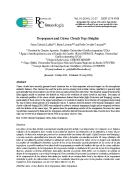Please use this identifier to cite or link to this item:
https://repositorio.uca.edu.ar/handle/123456789/5412| Título: | Tropopause and cirrus clouds tops heights | Autor: | Lakkis, Susan Gabriela Lavorato, Mario Canziani, Pablo O. |
Otros colaboradores: | PEPACG – UCA/CONICET (Programa para el Estudio de Procesos Atmosféricos en el Cambio Global) | Palabras clave: | NUBES CIRRUS; TROPOPAUSA; LIDAR | Fecha de publicación: | 2010 | Editorial: | Universidad Católica Argentina | Cita: | Lakkis, S. G., M. Lavorato y P. O. Canziani. 2011. Tropopause and cirrus clouds tops heights [en línea]. Revista de Climatología. 10. Disponible en: https://repositorio.uca.edu.ar/handle/123456789/5412 | Resumen: | Resumen: Las nubes cirrus han atraído recientemente mucha atención debido a su importante rol e impacto en el balance radiativo de la atmósfera. Esto resalta la necesidad de mejorar las mediciones de la atmósfera, a través de por ejemplo, la detección remota que proveen los sistemas lidar (acrónimo del inglés: light Detection and Ranging), con una excelente capacidad para detectar nubes altas y delgadas con mucha precisión. El rango dinámico del lidar de retrodifusión permite analizar la altitud así como la evolución de nubes cirrus en tiempo real. Mediante los perfiles de retrodifusión obtenidos a partir de los cirrus detectados y particularmente de los cirrus de la alta troposfera, es posible analizar la evolución de la tropopausa por medio del análisis del tope de los cirrus, utilizándolos como trazadores de la tropopausa. En el presente trabajo se analizaron 80 casos de cirrus de la tropopausa diurnos, elegidos en forma arbitraria, detectados durante el período 2001-2006, con el objetivo de estimar la altura de la tropopausa y su evolución temporal. Esta contribución presenta los primeros resultados preliminares de la comparación de las alturas detectadas por medio de un sistema lidar local y las alturas de la tropopausa obtenidas a partir de radiosondeos locales. Los resultados muestran que estos cirrus pueden considerarse como trazadores de la tropopausa, con un error típico inferior a 1 km. Abstract: Cirrus clouds have recently garnered much attention due to their important role and impact on the atmospheric radiative balance. This stresses the need for active remote sensing such as lidar, whose capability to perceive high and optically thin cirrus makes it one of the most accurate systems for cirri study. The dynamic range of backscatter lidar signals enable to measure the altitude as well as the evolution of cirrus clouds in real time. By means of the retrievals profiles of the cirrus clouds parameters derived from lidar (light Detection and Ranging) system, particularly of those close to the upper troposphere, it is possible to analyze the evolution of tropopause layer using the top of cirrus clouds present as a tropopause tracer. A random selected dataset of 80 diurnal tropopause cirrus clouds collected during 2001-2006 were analyzed in order to estimate tropopause height and its temporal evolution with the altitude of the cirrus tops. We present here the preliminary results of the comparison between the cirrus top altitudes measured by lidar and the tropopause altitudes derived from rawinsonde data. Results show that cirrus tops can be viewed as tropopause tracers with an accuracy close to 1km. |
URI: | https://repositorio.uca.edu.ar/handle/123456789/5412 | Disciplina: | INGENIERIA AMBIENTAL | Derechos: | Acceso Abierto |
| Appears in Collections: | Artículos |
Files in This Item:
| File | Description | Size | Format | |
|---|---|---|---|---|
| tropopause-cirrus-clouds-tops-heights.pdf | 310,59 kB | Adobe PDF |  View/Open |
Page view(s)
98
checked on Apr 27, 2024
Download(s)
46
checked on Apr 27, 2024
Google ScholarTM
Check
This item is licensed under a Creative Commons License

